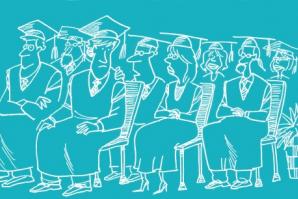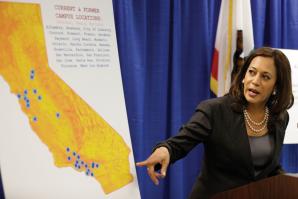As legislators duke it out in the Capitol and college regents slash services and raise fees, Adam Thongsavat is viewing education in California a bit differently. Namely, the UC Davis senior has been watching the growing line of students waiting for free food.
The Pantry, operated by the Associated Students, opens its doors at noon in the basement of the university’s Freeborn Hall. Students flash school identification cards and get their choice of three food items, such as bread, peanut butter or soup.
“It’s a very humbling experience,” says Thongsavat, student body president. “You think of UC Davis, and it’s a 21st-century research institution. We have football games and famous speakers and great concerts. But in the basement at Freeborn, there’s a darker side. We have hundreds of students coming to get food every week, and we’re seeing the numbers steadily increase.”
A recent survey of UC Davis undergrads found almost 25 percent “somewhat to very often” skipped meals to save money, and another 25 percent “occasionally” skipped meals for the same reason.
While The Pantry is obviously a valuable resource to students, Thongsavat wonders: “Are we really solving the root of the issue?”
California’s higher education system is under siege with the recession and state budget deficit tearing into services and sending tuition and fees skyrocketing at an alarming rate. The trend is eating away at California’s branding of affordable, quality, public education and its legacy of a highly trained work force.
At the ground level, the classroom cuts and fee increases mean financial hardship for students: taking on more debt, dropping majors and minors, delaying graduations or spiking dreams of college education altogether.
While college diplomas are deferred or dashed, students take longer to become workers and pay less in taxes if they get a lower-paying job.
As students scramble for fewer classes in their concentration and competition remains high for spots in some state-funded schools, many students are turning to private, for-profit universities and vocational schools, where they are promised classes in their field, a quick turnaround and job placement.
Meanwhile, the trend toward costly college tuitions and student debt has sparked a national debate over whether conventional postsecondary education is worth the money.
State officials and legislators argue California’s public colleges and universities are still among the best value in the nation, but there’s no question students and their families are shelling out dramatically more in tuition at state-funded schools.
The state budget approved in June slashed another $150 million each from the California State University and University of California systems, on top of $500 million cut from each system earlier in the year, for a total reduction of $650 million for each so far this year.
The newest round of state reductions represents about 22 percent of the UC’s total general fund budget and about 24 percent of the CSU general fund. The budget also created a trigger mechanism that would cause more cuts in December if state revenues fall below projections, raising the specter of further tuition hikes at year’s end.
State contributions to the UC system have been slashed by $811 million since 2008, leading to fee increases of 55.4 percent since the 2007-2008 school year. Lawmakers sliced $782 million from the CSU system in the past two years, hiking fees by 62.1 percent since the 2007-2008 school year
At the CSUs, total cost for a full-time student went from $3,521 a year to $5,834 over the previous three years, and the UCs went from charging $7,517 a year to $12,150. Since 2007-2008, California community college tuition went from $20 a unit to $36 per unit.
Mike Uhlenkamp, spokesman for the CSU system, says late budget approvals and the volatility of the economy has wreaked havoc on planned enrollment and services at state colleges.
He said 2007-2008 was the last year of predictable funding with the state contributing $2.97 billion to CSUs. Then the state cut more than $600 million over the next two years, dropping the state funding to $2.35 billion. This year, some stimulus funds restored parts of the CSU budget, bringing the state contribution to $2.77 billion.
Future budget cuts, however, could lower that considerably, he says.
“In conjunction with the recession, the cuts forced us to raise tuition to generate revenue,” Uhlenkamp says. “In the past four years, it’s caused some real spikes. Because there was such a large cut in 2009-2010, we had to react quickly, and there was a lot of havoc in the system. It started cutting into the quality of what we’re trying to do.”
That year, CSU staff was forced to take unpaid furloughs two days a month, saving $170 million, Uhlenkamp says. “We’re still turning over every stone to keep up the quality of the institutions while saving money,” he says.
Marty Block, assembly chair of the higher education committee, says increases in costs of textbooks and student health care, along with rising salaries is partially to blame for the economic crunch in state-funded colleges and universities.
Many students are turning to private, for-profit universities and vocational schools, where they are promised classes in their field, a quick turnaround and job placement.
But the real culprit is simply the recession.
“Because of recession, we have much less in state budget,” says Assemblyman Block, a Democrat and former educator from the San Diego area. He says higher education makes up about 10 percent of state spending. “Before the downturn, we had $130 billion in our budget, now we’re at $85 billion. We’re trying to run the same system with substantially fewer dollars.”
The toll on students is obvious and direct, Block says.
“Access has been reduced for students to get into college,” he says. “They are turning to private, for-profit alternatives or foregoing education altogether. They are dooming themselves to a life where they make less money, have a lower standard of living and contribute less back to the state during their careers.”
Block says typical students use more state funding than they provide while in school, so it behooves the state to get students through on time. He sees higher education students as an investment for the state, which, in his view, should pay for students to get their education in hopes of collecting higher taxes for years to come.
“Students are taking longer to get a degree, which costs students extra dollars, and we are carrying the costs of opportunities lost,” Block says. “If they could graduate, these students would be working, buying and paying taxes. Instead, the state is losing money through a loss of productivity.”
Forty-five of 50 states are seeing significant increases in tuition fees, Block says, and California’s community college tuition is still the lowest.
A study by student-aid websites Fastweb.com and FinAid.org shows that college tuition nationwide is rising at an annual rate of about 5 percent. The average amount of debt taken on by college students graduating in 2011 will be the highest ever at $22,900 per student, an 8 percent jump over last year’s debt.
The Federal Reserve Bank of New York reported that U.S. student debt totals $530 million, and interest rates on many student loans can be as high as subprime mortgages. When compared to student debt rates a decade ago, the current rate is up 47 percent, adjusted for inflation.
Still, the study found that college is a good investment for students and their communities. The annual pretax income of households headed by people with at least a college degree outpaced those with lower levels of education by 101 percent. The recent unemployment rate for college graduates was 4.5 percent, compared to high school graduates at 9.7 percent.
If left unabated, however, budget cuts and tuition increases will start to unravel the mission of publicly funded schools, Block says.
“Cost shouldn’t discriminate against students due to socioeconomic levels,” he says. “It shouldn’t keep them from coming in the door.”
One of the silver linings of the recession has been an uptick in enrollment at private, for-profit postsecondary schools, Block says. The quality and impact of the higher cost of education at some for-profit colleges is still unknown, he adds.
“They’re growing at a rapid pace because students have no less-expensive, publicly funded option,” Block says of the for-profit education sector. “To their credit, they do turn out some fine graduates.”
Block says teaching methods at for-profit schools, particularly online schools, may not fit the learning styles of all students and called on the state to better monitor performance and the debt load for students attending for-profit schools.
“I’m concerned about student debt at trade and vocational schools, such as beauty colleges and tech schools,” Block says. “Some of the results on performance are mixed. But the good ones do serve an important purpose in providing access. Many students have nowhere else to go.”
Bob Eoff, territory vice president for University of Phoenix, says total enrollment at the for-profit college system is growing slightly, but it’s also been stalled by the effects of the recession.
More dramatic is the steady increase in transfers from community colleges over the past decade, Eoff says. In the 1996-1997 academic year, the number of California community college students transferring to University of Phoenix was 2,190, and in 2008, that figure had skyrocketed to 8,825 students.
“The community colleges are eliminating certain programs, capping the number of units and limiting enrollment, so many folks are looking to us,” Eoff says. “Part of the increase is due to more awareness about our online classes and the flexibility offered, but part is due to pressure in community colleges.”
A recent study by Los Rios Community College District indicates many local community college students are transferring to private or out-of-state institutions rather than state-funded schools. In 2009-2010, 2,222 students transferred to UC or CSU schools, while 3,212 transferred elsewhere. District officials cited the state cuts in funding and enrollment as reasons students were finding alternatives.
Eoff says alternatives to state-subsidized college educations are crucial to the growing demand for a highly trained work force. In 1950, 20 percent of jobs required a bachelor’s degree or higher; today, 60 percent of jobs require a four-year college diploma, he says.
“We play a huge role in bridging that gap,” Eoff says. “President Obama has challenged the U.S. to meet a goal in 2020 of having the highest college graduation rate of any developed nation. If we relied on the traditional education infrastructure, it’s estimated that would take 1,000 extra universities and $300 billion. It’s a fine system, but it’s not realistic to think it can educate all the people we need to have a prepared labor pool.”
Recommended For You

Attention College Shoppers
Graduates' employment data may not tell the whole truth
Workers increasingly need a college degree to survive in today’s complex economy, so as college costs and student loan loads rise, parents and prospective students are asking tougher questions about the results to expect from a baccalaureate. But the answers they’re getting are often inadequate




